2016 TOYOTA TUNDRA trailer
[x] Cancel search: trailerPage 3 of 588
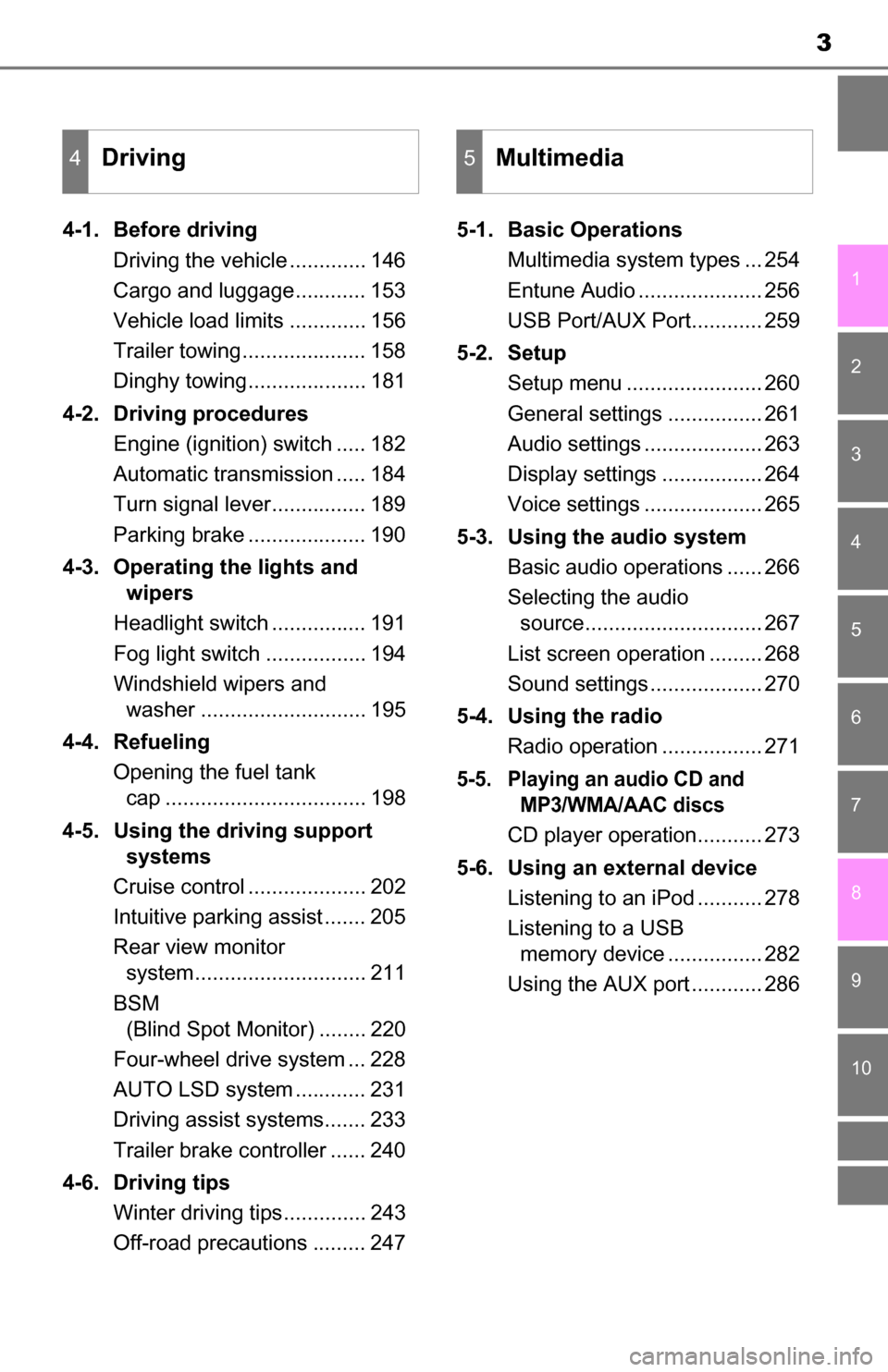
3
1
9 8
7 5 4
3
2
10
6
4-1. Before drivingDriving the vehicle ............. 146
Cargo and luggage............ 153
Vehicle load limits ............. 156
Trailer towing..................... 158
Dinghy towing.................... 181
4-2. Driving procedures Engine (ignition) switch ..... 182
Automatic transmission ..... 184
Turn signal lever................ 189
Parking brake .................... 190
4-3. Operating the lights and wipers
Headlight switch ................ 191
Fog light switch ................. 194
Windshield wipers and washer ............................ 195
4-4. Refueling Opening the fuel tank cap .................................. 198
4-5. Using the driving support systems
Cruise control .................... 202
Intuitive parking assist ....... 205
Rear view monitor system............................. 211
BSM (Blind Spot Monitor) ........ 220
Four-wheel drive system ... 228
AUTO LSD system ............ 231
Driving assist systems....... 233
Trailer brake controller ...... 240
4-6. Driving tips Winter driving tips.............. 243
Off-road precautions ......... 247 5-1. Basic Operations
Multimedia system types ... 254
Entune Audio ..................... 256
USB Port/AUX Port............ 259
5-2. Setup Setup menu ....................... 260
General settings ................ 261
Audio settings .................... 263
Display settings ................. 264
Voice settings .................... 265
5-3. Using the audio system Basic audio operations ...... 266
Selecting the audio source.............................. 267
List screen operation ......... 268
Sound settings ................... 270
5-4. Using the radio Radio operation ................. 271
5-5. Playing an audio CD and MP3/WMA/AAC discs
CD player operation........... 273
5-6. Using an external device Listening to an iPod ........... 278
Listening to a USB memory device ................ 282
Using the AUX port ............ 286
4Driving5Multimedia
Page 20 of 588
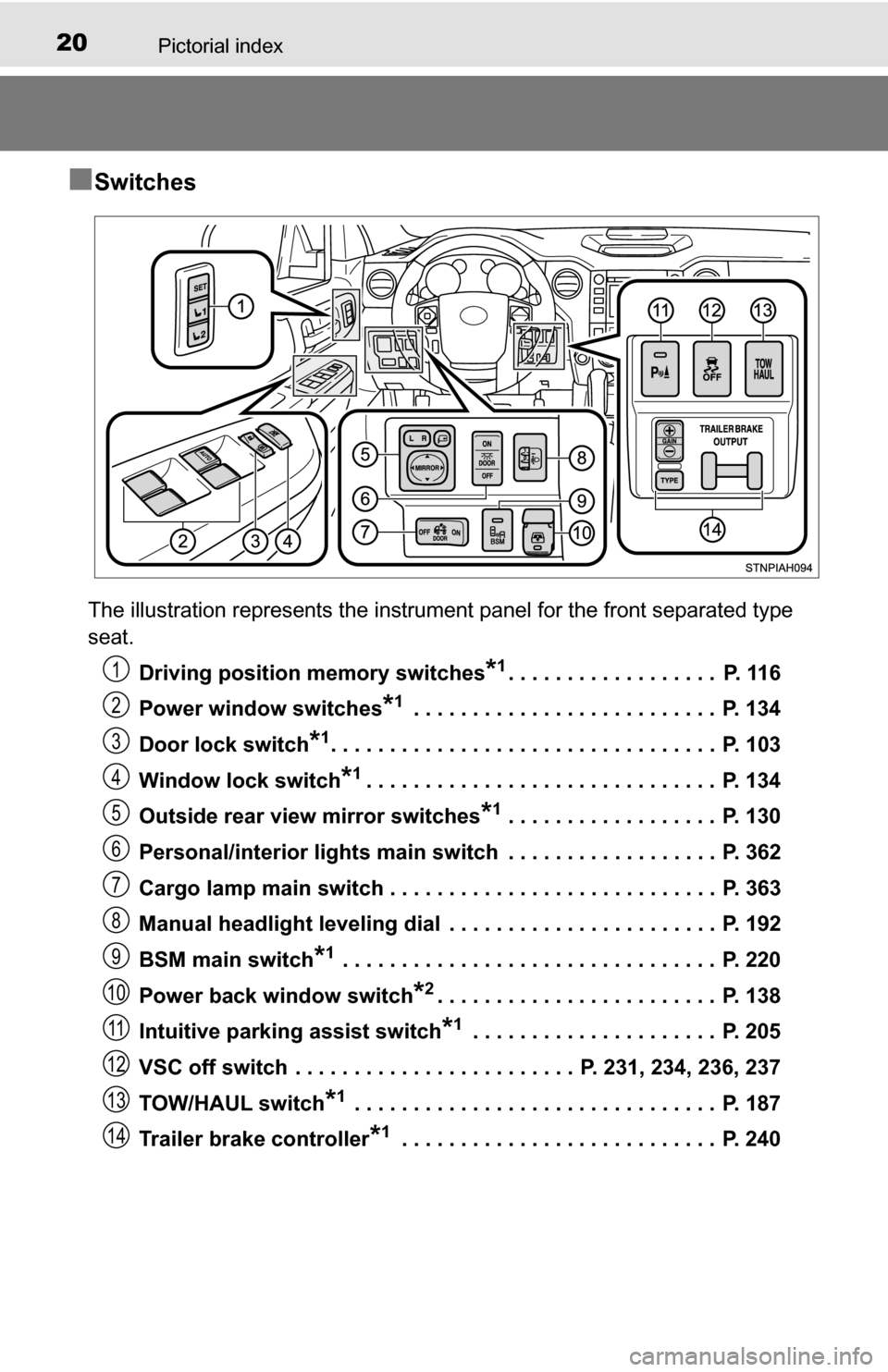
20Pictorial index
■Switches
The illustration represents the instrument panel for the front separated\
type
seat.Driving position memory switches
*1. . . . . . . . . . . . . . . . . . P. 116
Power window switches
*1 . . . . . . . . . . . . . . . . . . . . . . . . . . P. 134
Door lock switch
*1. . . . . . . . . . . . . . . . . . . . . . . . . . . . . . . . . P. 103
Window lock switch
*1. . . . . . . . . . . . . . . . . . . . . . . . . . . . . . P. 134
Outside rear view mirror switches
*1 . . . . . . . . . . . . . . . . . . P. 130
Personal/interior lights main switch . . . . . . . . . . . . . . . . . . P. 362
Cargo lamp main switch . . . . . . . . . . . . . . . . . . . . . . . . . . . . P. 363
Manual headlight leveling dial . . . . . . . . . . . . . . . . . . . . . . . P. 192
BSM main switch
*1 . . . . . . . . . . . . . . . . . . . . . . . . . . . . . . . . P. 220
Power back window switch
*2. . . . . . . . . . . . . . . . . . . . . . . . P. 138
Intuitive parking assist switch
*1 . . . . . . . . . . . . . . . . . . . . . P. 205
VSC off switch . . . . . . . . . . . . . . . . . . . . . . . . P. 231, 234, 236, 237
TOW/HAUL switch
*1 . . . . . . . . . . . . . . . . . . . . . . . . . . . . . . . P. 187
Trailer brake controller
*1 . . . . . . . . . . . . . . . . . . . . . . . . . . . P. 240
1
2
3
4
5
6
7
8
9
10
11
12
13
14
Page 77 of 588
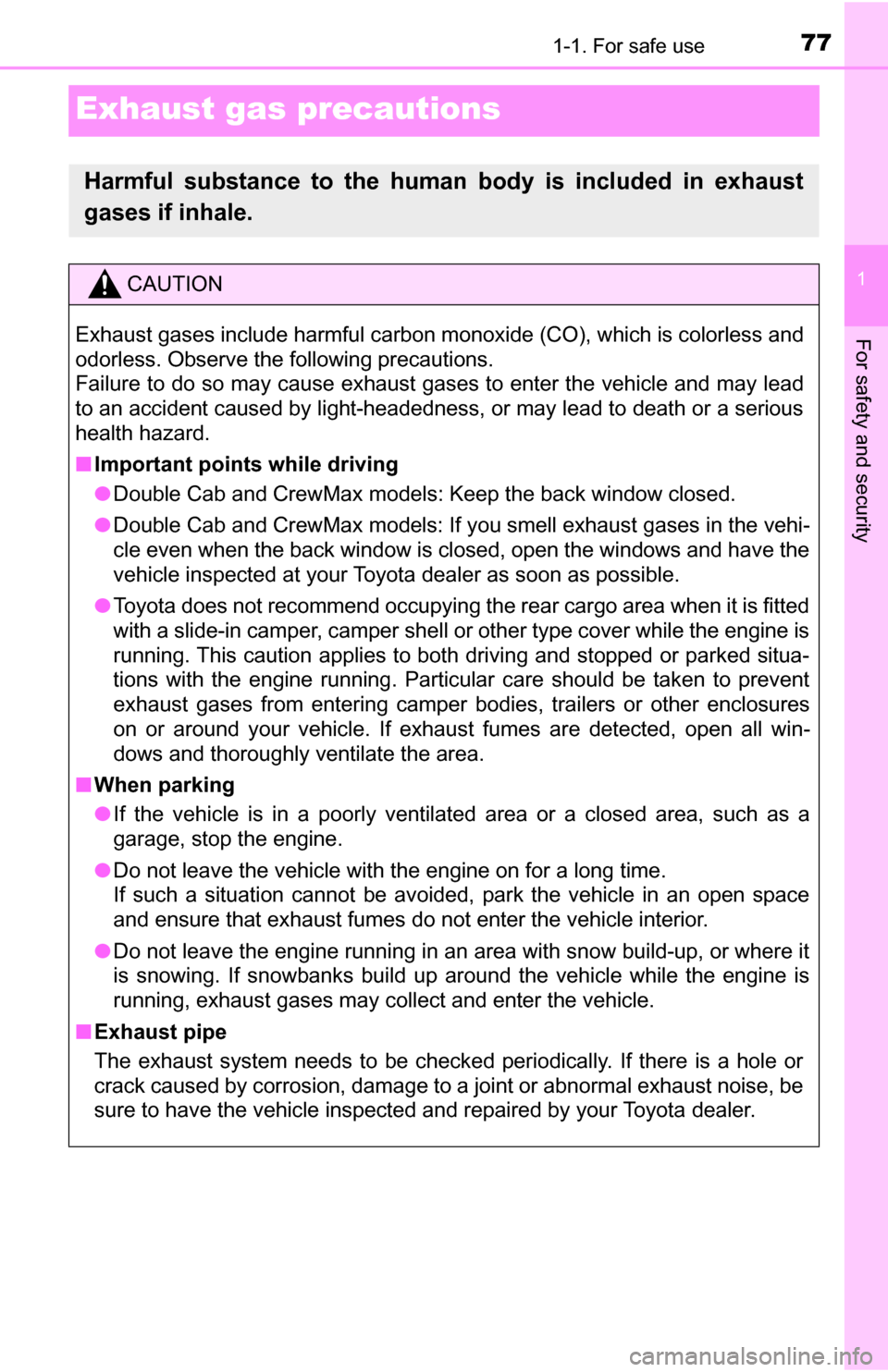
771-1. For safe use
1
For safety and security
Exhaust gas precautions
Harmful substance to the human body is included in exhaust
gases if inhale.
CAUTION
Exhaust gases include harmful carbon monoxide (CO), which is colorless and
odorless. Observe the following precautions.
Failure to do so may cause exhaust gases to enter the vehicle and may lead
to an accident caused by light-headedness, or may lead to death or a serious
health hazard.
■ Important points while driving
● Double Cab and CrewMax models: Keep the back window closed.
● Double Cab and CrewMax models: If you smell exhaust gases in the vehi-
cle even when the back window is closed, open the windows and have the
vehicle inspected at your Toyota dealer as soon as possible.
● Toyota does not recommend occupying the rear cargo area when it is fitted
with a slide-in camper, camper shell or other type cover while the engine is
running. This caution applies to both driving and stopped or parked situa-
tions with the engine running. Particular care should be taken to prevent
exhaust gases from entering camper bodi es, trailers or other enclosures
on or around your vehicle. If exhaust fumes are detected, open all win-
dows and thoroughly ventilate the area.
■ When parking
● If the vehicle is in a poorly ventilated area or a closed area, such as a
garage, stop the engine.
● Do not leave the vehicle with the engine on for a long time.
If such a situation cannot be avoided, park the vehicle in an open space
and ensure that exhaust fumes do not enter the vehicle interior.
● Do not leave the engine running in an area with snow build-up, or where it
is snowing. If snowbanks build up around the vehicle while the engine is
running, exhaust gases may collect and enter the vehicle.
■ Exhaust pipe
The exhaust system needs to be checked periodically. If there is a hole or
crack caused by corrosion, damage to a joint or abnormal exhaust noise, be
sure to have the vehicle inspected and repaired by your Toyota dealer.
Page 86 of 588
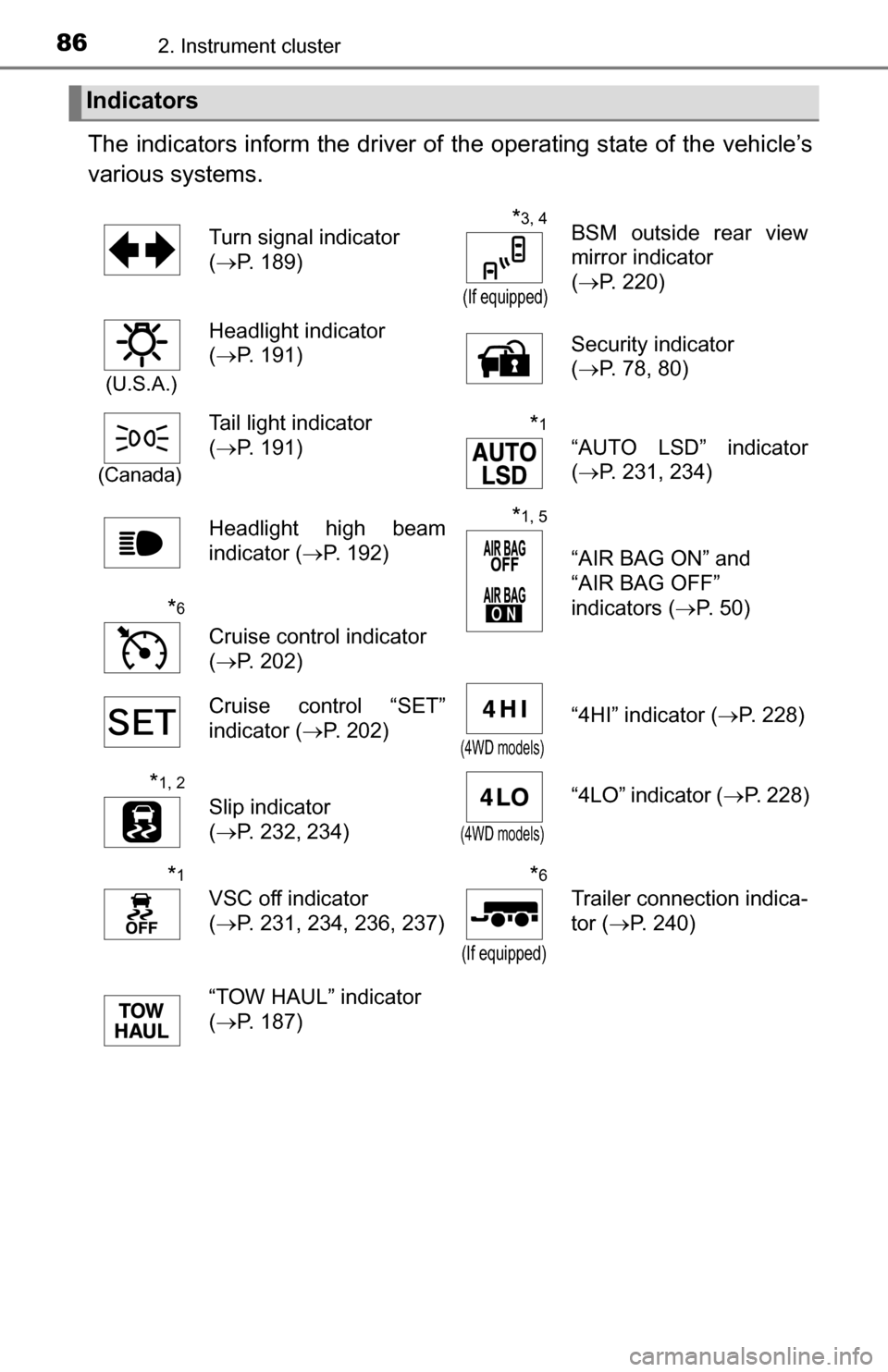
862. Instrument cluster
The indicators inform the driver of the operating state of the vehicle’s
various systems.
Indicators
Turn signal indicator
( P. 189)*3, 4
(If equipped)
BSM outside rear view
mirror indicator
(P. 220)
(U.S.A.)
Headlight indicator
(P. 191) Security indicator
(
P. 78, 80)
(Canada)
Tail light indicator
(P. 191)*1
“AUTO LSD” indicator
(P. 231, 234)
Headlight high beam
indicator ( P. 192)
*1, 5
“AIR BAG ON” and
“AIR BAG OFF”
indicators ( P. 50)
*6
Cruise control indicator
(P. 202)
Cruise control “SET”
indicator ( P. 202)
(4WD models)
“4HI” indicator ( P. 228)
*1, 2
Slip indicator
(P. 232, 234)
(4WD models)
“4LO” indicator ( P. 228)
*1
VSC off indicator
(P. 231, 234, 236, 237)
*6
(If equipped)
Trailer connection indica-
tor ( P. 240)
“TOW HAUL” indicator
( P. 187)
Page 132 of 588
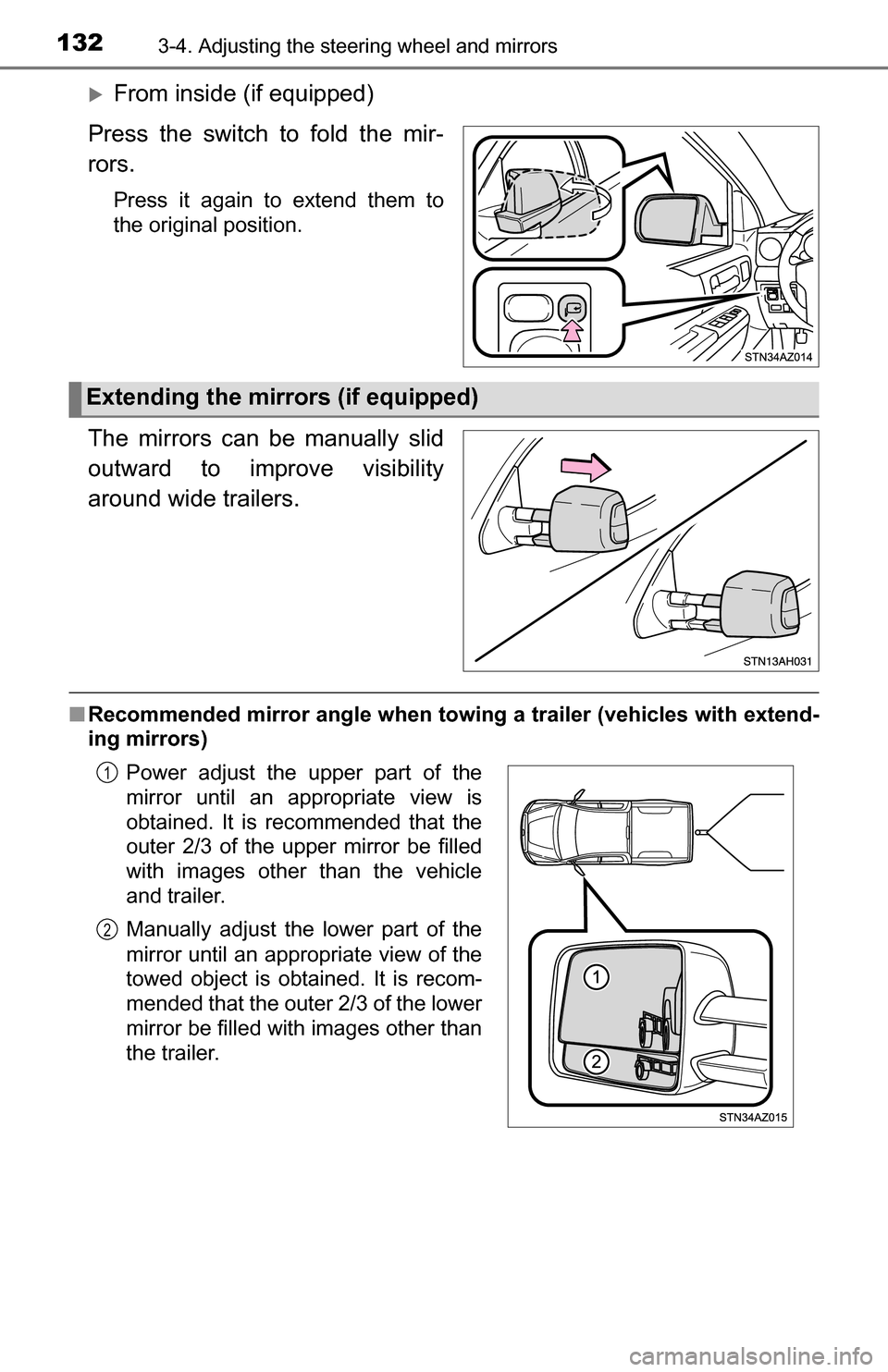
1323-4. Adjusting the steering wheel and mirrors
From inside (if equipped)
Press the switch to fold the mir-
rors.
Press it again to extend them to
the original position.
The mirrors can be manually slid
outward to improve visibility
around wide trailers.
■ Recommended mirror angle when to wing a trailer (vehicles with extend-
ing mirrors)
Extending the mirrors (if equipped)
Power adjust the upper part of the
mirror until an appropriate view is
obtained. It is recommended that the
outer 2/3 of the upper mirror be filled
with images other than the vehicle
and trailer.
Manually adjust the lower part of the
mirror until an appropriate view of the
towed object is obtained. It is recom-
mended that the outer 2/3 of the lower
mirror be filled with images other than
the trailer.1
2
Page 145 of 588
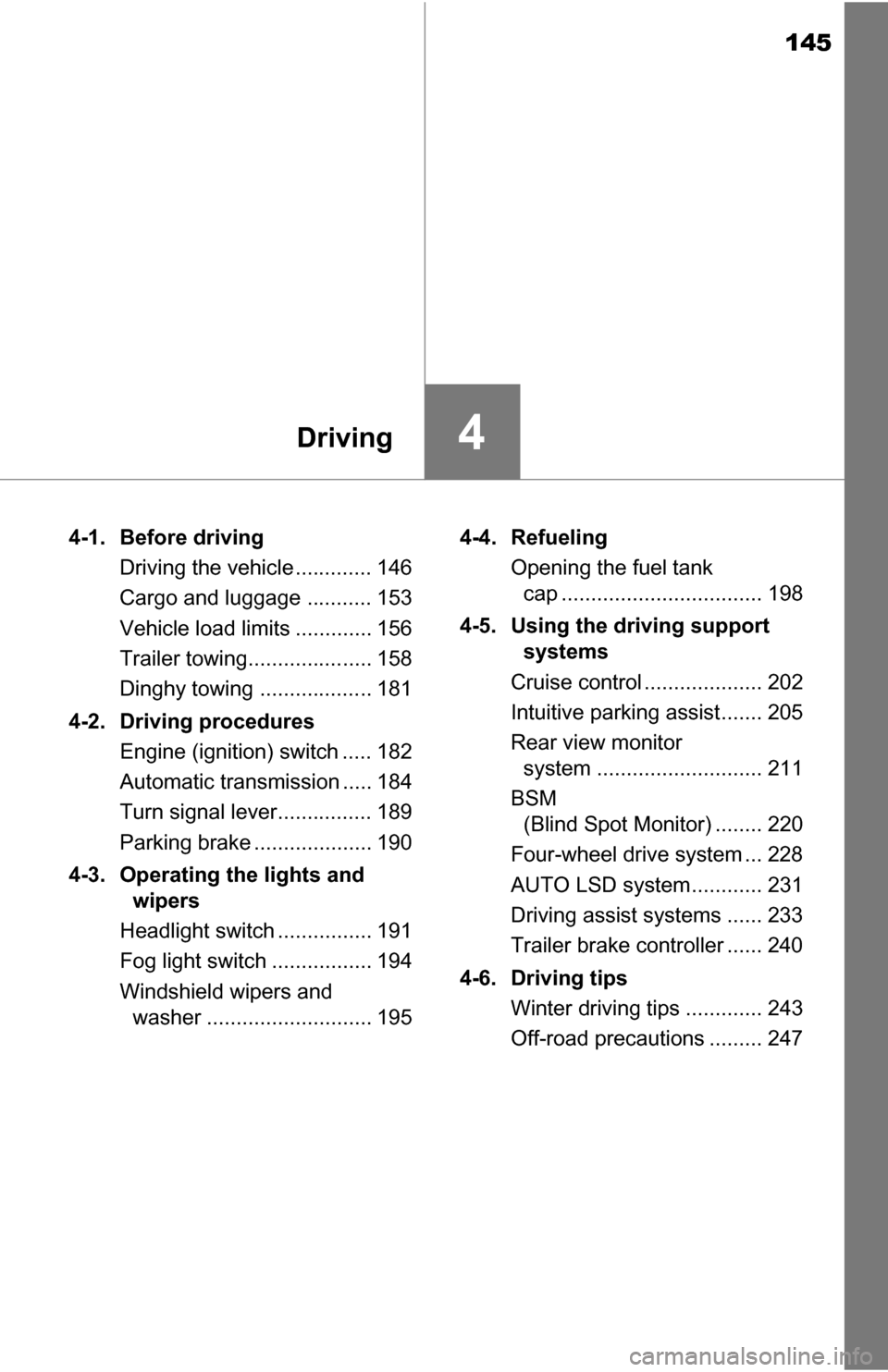
145
4Driving
4-1. Before drivingDriving the vehicle ............. 146
Cargo and luggage ........... 153
Vehicle load limits ............. 156
Trailer towing..................... 158
Dinghy towing ................... 181
4-2. Driving procedures Engine (ignition) switch ..... 182
Automatic transmission ..... 184
Turn signal lever................ 189
Parking brake .................... 190
4-3. Operating the lights and wipers
Headlight switch ................ 191
Fog light switch ................. 194
Windshield wipers and washer ............................ 195 4-4. Refueling
Opening the fuel tank cap .................................. 198
4-5. Using the driving support systems
Cruise control .................... 202
Intuitive parking assist....... 205
Rear view monitor system ............................ 211
BSM (Blind Spot Monitor) ........ 220
Four-wheel drive system ... 228
AUTO LSD system............ 231
Driving assist systems ...... 233
Trailer brake controller ...... 240
4-6. Driving tips Winter driving tips ............. 243
Off-road precautions ......... 247
Page 147 of 588
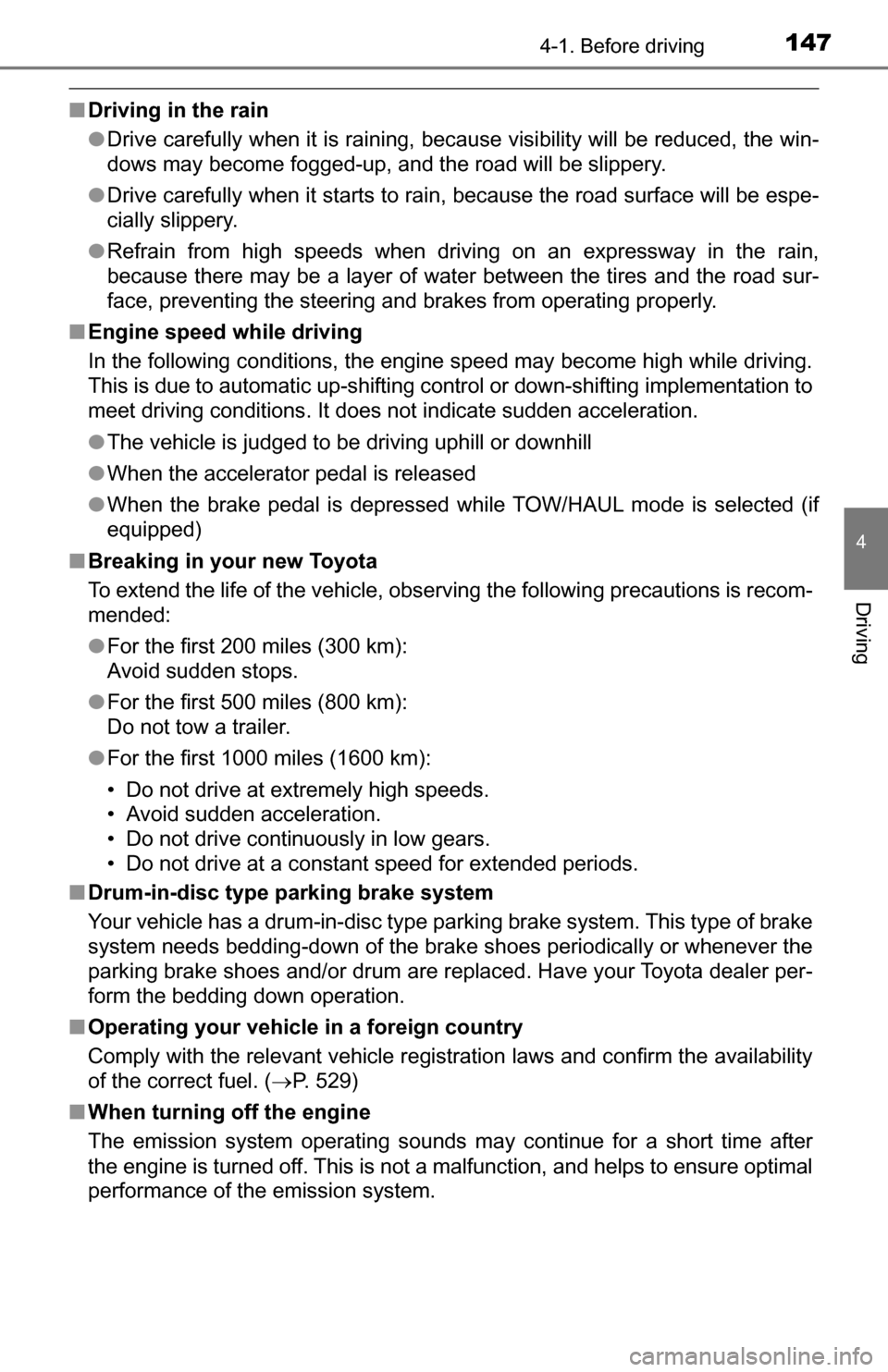
1474-1. Before driving
4
Driving
■Driving in the rain
●Drive carefully when it is raining, because visibility will be reduced, the win-
dows may become fogged-up, and the road will be slippery.
● Drive carefully when it starts to rain, because the road surface will be espe-
cially slippery.
● Refrain from high speeds when driving on an expressway in the rain,
because there may be a layer of water between the tires and the road sur-
face, preventing the steering and brakes from operating properly.
■ Engine speed while driving
In the following conditions, the engine speed may become high while driving.
This is due to automatic up-shifting control or down-shifting implementation to
meet driving conditions. It does not indicate sudden acceleration.
●The vehicle is judged to be driving uphill or downhill
● When the accelerator pedal is released
● When the brake pedal is depressed while TOW/HAUL mode is selected (if
equipped)
■ Breaking in your new Toyota
To extend the life of the vehicle, observing the following precautions is recom-
mended:
●For the first 200 miles (300 km):
Avoid sudden stops.
● For the first 500 miles (800 km):
Do not tow a trailer.
● For the first 1000 miles (1600 km):
• Do not drive at extremely high speeds.
• Avoid sudden acceleration.
• Do not drive continuously in low gears.
• Do not drive at a constant speed for extended periods.
■ Drum-in-disc type parking brake system
Your vehicle has a drum-in-disc type par king brake system. This type of brake
system needs bedding-down of the brake shoes periodically or whenever the
parking brake shoes and/or drum are replaced. Have your Toyota dealer per-
form the bedding down operation.
■ Operating your vehicle in a foreign country
Comply with the relevant vehicle registration laws and confirm the availability
of the correct fuel. ( P. 529)
■ When turning off the engine
The emission system operating sounds may continue for a short time after
the engine is turned off. This is not a malfunction, and helps to ensure optimal
performance of the emission system.
Page 153 of 588
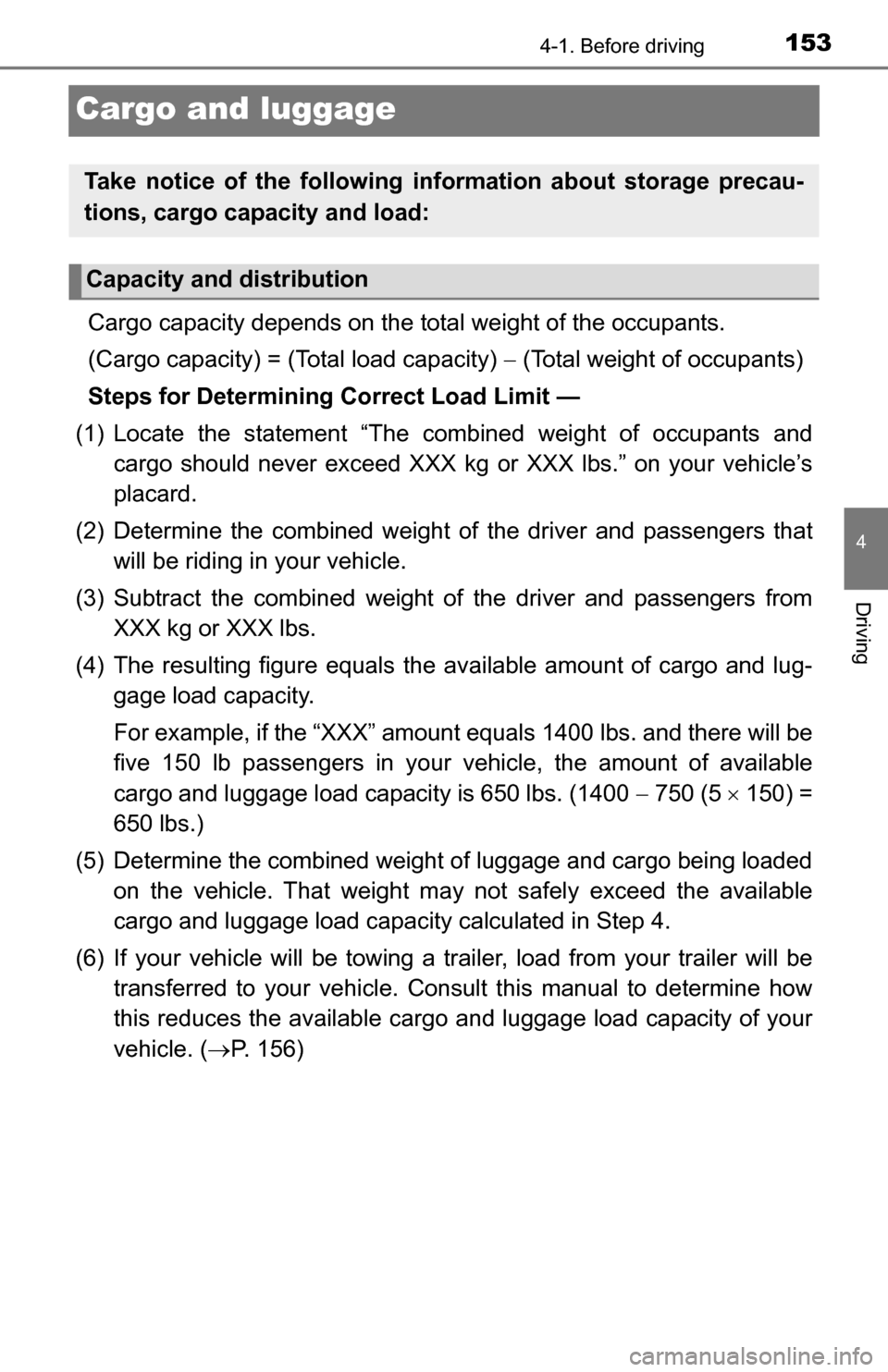
1534-1. Before driving
4
Driving
Cargo and luggage
Cargo capacity depends on the total weight of the occupants.
(Cargo capacity) = (Total load capacity) (Total weight of occupants)
Steps for Determining Correct Load Limit —
(1) Locate the statement “The comb ined weight of occupants and
cargo should never exceed XXX kg or XXX lbs.” on your vehicle’s
placard.
(2) Determine the combined weight of the driver and passengers that
will be riding in your vehicle.
(3) Subtract the combined weight of the driver and passengers from
XXX kg or XXX lbs.
(4) The resulting figure equals the available amount of cargo and lug- gage load capacity.
For example, if the “ XXX” amount equals 1400 lbs. and there will be
five 150 lb passengers in your v ehicle, the amount of available
cargo and luggage load capacity is 650 lbs. (1400 750 (5150) =
650 lbs.)
(5) Determine the combined weight of luggage and cargo being loaded on the vehicle. That weight ma y not safely exceed the available
cargo and luggage load capacity calculated in Step 4.
(6) If your vehicle will be towing a tr ailer, load from your trailer will be
transferred to your vehicle. Consult this manual to determine how
this reduces the available cargo and luggage load capacity of your
vehicle. ( P. 156)
Take notice of the following information about storage precau-
tions, cargo capacity and load:
Capacity and distribution